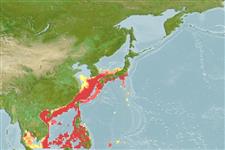Common names from other countries
Environment: milieu / climate zone / depth range / distribution range
Ecologie
; diepteverspreiding 49 - 314 m (Ref. 4), usually 100 - 250 m (Ref. 4). Tropical; 14°C - 24°C (Ref. 112711), preferred 24°C (Ref. 107945); 38°N - 6°N, 99°E - 142°E (Ref. 4)
Western Pacific.
Length at first maturity / Size / Gewicht / Leeftijd
Maturity: Lm ? range ? - ? cm Max length : 23.0 cm TL mannelijk/geslacht niet bekend; (Ref. 4)
It has a maximum total length of 23 cm; and a carapace length of 4 to 7.6 cm (male) and 4 to 8 cm (female), 6 to 8 cm (ovigerous female) (Ref. 4).
Life cycle and mating behavior
Geslachtsrijpheid | Voortplanting | Kuitschieten | Eieren | Fecundity | Larven
Members of the order Decapoda are mostly gonochoric. Mating behavior: Precopulatory courtship ritual is common (through olfactory and tactile cues); usually indirect sperm transfer.
Holthuis, L.B. 1991. (Ref. 4)
Status op de Rode Lijst van het IUCN (Ref. 130435: Version 2024-1)
Status bij CITES (Ref. 108899)
Not Evaluated
Not Evaluated
Gebruik door de mens
Visserij: commercieel
FAO - Visserij: landings | FishSource | Sea Around Us
Tools
Meer informatie
Leeftijd/Grootte
Groei
Lengte-gewicht parameters
Lengte-lengte parameters
Morfologie
Larven
Abundantie
Internet-bronnen
Estimates based on models
Preferred temperature
(Ref.
115969): 17.5 - 26.7, mean 21.1 (based on 214 cells).
Kwetsbaarheid
Low vulnerability (13 of 100).
